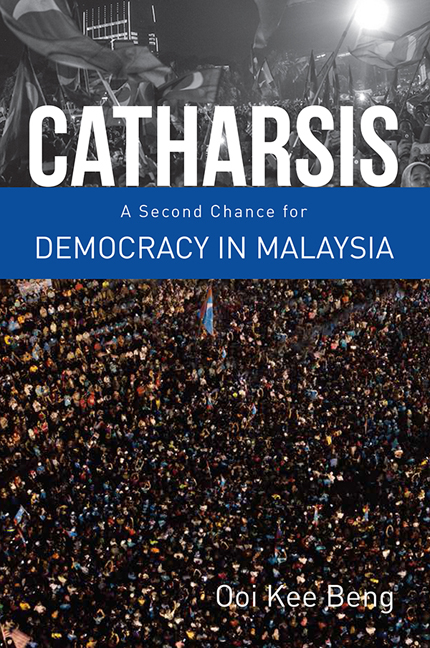Book contents
- Frontmatter
- Contents
- Foreword
- 1 Introduction – Malaysia's Future Is Redeemed
- Before Pakatan Harapan
- Before 9 May 2018
- With Mahathir at the Helm
- 31 One Thing Is Certain—There Will Be More Amendments to the Constitution
- 32 The More Things Change, the More Things May Actually Change
- 33 Did Merdeka Liberate or Create Malaya?
- 34 Interview with Nurul Izzah Anwar: Rebuilding a Nation Long Divided
- 35 The Diminishing of Humans Through Identity Politics
- 36 The Art of Dismantling Cultural Pluralism
- 37 No Need to Let Bigots Dictate Policy
- 38 What the Penang Floods Say About Malaysian Politics (and It's Not Just About Climate Change)
- 39 This is the Moment of Truth for Malaysia's Race-based Politics
- 40 We are Equal Only Through Our Vote
- 41 Why the Opposition Has a Shot at Toppling the Barisan Nasional with Mahathir at the Helm
- 42 Spiralling Back towards Reformasi
- 43 Individual Freedom Is a Matter of National Survival
- 44 Why Meet the Twenty-first Century with Twentieth Century Mindsets?
- 45 A Final Quarrel between a Repentant Grandfather and Oldfashioned Self-absorbed Parents
- 46 Outraged Enough to Go Vote or Cynical Enough to Stay Home?
- Beyond 9 May 2018
- About the Author
32 - The More Things Change, the More Things May Actually Change
from With Mahathir at the Helm
Published online by Cambridge University Press: 12 February 2019
- Frontmatter
- Contents
- Foreword
- 1 Introduction – Malaysia's Future Is Redeemed
- Before Pakatan Harapan
- Before 9 May 2018
- With Mahathir at the Helm
- 31 One Thing Is Certain—There Will Be More Amendments to the Constitution
- 32 The More Things Change, the More Things May Actually Change
- 33 Did Merdeka Liberate or Create Malaya?
- 34 Interview with Nurul Izzah Anwar: Rebuilding a Nation Long Divided
- 35 The Diminishing of Humans Through Identity Politics
- 36 The Art of Dismantling Cultural Pluralism
- 37 No Need to Let Bigots Dictate Policy
- 38 What the Penang Floods Say About Malaysian Politics (and It's Not Just About Climate Change)
- 39 This is the Moment of Truth for Malaysia's Race-based Politics
- 40 We are Equal Only Through Our Vote
- 41 Why the Opposition Has a Shot at Toppling the Barisan Nasional with Mahathir at the Helm
- 42 Spiralling Back towards Reformasi
- 43 Individual Freedom Is a Matter of National Survival
- 44 Why Meet the Twenty-first Century with Twentieth Century Mindsets?
- 45 A Final Quarrel between a Repentant Grandfather and Oldfashioned Self-absorbed Parents
- 46 Outraged Enough to Go Vote or Cynical Enough to Stay Home?
- Beyond 9 May 2018
- About the Author
Summary
The elections are coming, and the array of political parties facing each other across the widening divide can be stupefying for any observer newly arrived on the Malaysian scene.
It would seem therefore that a quick look at the historical context in which some of Malaysia's major political parties came into being would provide some badly needed understanding of where the country's politics is heading.
Let us start with UMNO. The United Malays National Organisation started out in 1946 in reaction to Britain's fateful eagerness to rearrange its colonies into a manageable form following its diminished capacity to rule an empire following the Second World War.
The hasty and underhanded manner in which it implemented the Malayan Union that year, partially based on a faulty understanding of the basis of its authority in Malaya led to a revolt by the Malay community. Occurring as it did at a time when the rest of the Malay Archipelago was undergoing a surge of republican, leftist and anticolonial violence, the British quickly had second thoughts and swung as hastily in the other direction. And so, the Federation of Malaya quickly came into being in early 1948.
The chaotic reality on the ground, however, soon forced the architects of the Federation to Malaya Agreement to search for a middle ground where ethnic relations and ideology were concerned. On the side of the Chinese community, the political situation over recent decades had left them with influential local branches of political parties that had been fighting the Japanese in Mainland China, while the Indian community had on the one hand been excited by India's independence in 1947 and on the other radicalised by Subhas Chandra Bose's Indian National Army during the war.
To cut a long story short, the Malayan Chinese Association (MCA) was formed in 1949 to organise and unite anti-communist elements from among the Straits Chinese and from the local Kuomintang under one umbrella; and the Malayan Indian Congress (MIC), inspired by Mahatma Gandhi's Indian National Congress, came into being just after the war. UMNO and MCA, with MIC joining in 1955, became the backbone of the consociational system we know as the Alliance, which won the election so convincingly that year that the British had little official reason left not to grant independence to its assortment of colonies on the peninsula.
- Type
- Chapter
- Information
- CatharsisA Second Chance for Democracy in Malaysia, pp. 114 - 118Publisher: ISEAS–Yusof Ishak InstitutePrint publication year: 2018

